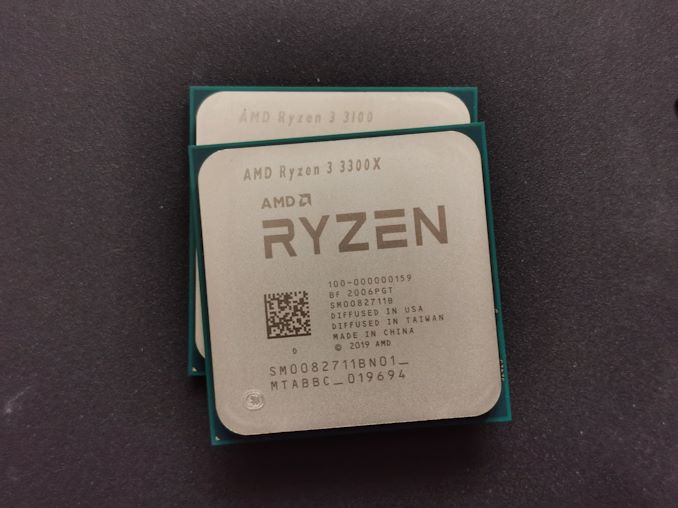The AMD Ryzen 3 3300X and 3100 CPU Review: A Budget Gaming Bonanza
by Dr. Ian Cutress on May 7, 2020 9:00 AM ESTThe Battering Ram of Time
A wouldn’t say a lot, but at least some discussion has been permeating through the airwaves since the Ryzen 3000 desktop launch as to what AMD was going to do in its sub-$200 space. Not having a latest generation product in a very active part of the market was missing from the portfolio, but initially AMD was happy for its previous generation CPUs and APUs to fill that role.
There were two schools of thought. The first is that AMD would launch lower core count CPUs, despite having a supposedly high yielding chiplet design that was going straight into its highest margin server product portfolio. Building a low core count chiplet design also incurs the added cost of bringing a chiplet and an IO die together in packaging, further decreasing margins. It seemed unlikely at the time.
The second school of thought would be that AMD would populate this part of the market with desktop versions of the Ryzen 4000 mobile APUs. These monolithic parts had integrated graphics, and would very likely easily scale from 45 W to 65 W for the desktop. Like previous APUs there would only be 8 PCIe lanes for external graphics, but for this generation also only PCIe 3.0 due to how the mobile APUs were powered.
Personally I assumed the second one, and that AMD would ignore the CPUs and go straight in for the APUs. I was perhaps unprepared for the apparent success of AMD’s mobile chips in the laptop space. We’ve reviewed the ASUS Zephyrus G14, a true flagship AMD notebook, and the Acer Swift 3, offering mind-bending performance and quality for the price. AMD is promoting 100+ design wins on Ryzen Mobile in 2020, global pandemic permitting, and the OEMs are jumping on the bandwagon it seems.
As we’ve shown in the review, this means that we get some CPUs. The Ryzen 3 3300X and Ryzen 3 3100 are odd elements to the Ryzen family, especially the 3100 with its awkward CCX and core configuration, but both parts offer a lot of performance for their pricing. At $120 and $99 respectively, using AMD’s latest Zen 2 microarchitecture and the power efficient 7nm TSMC process, AMD is defining a new baseline in budget performance.
This is personified in very much in comparing the AMD Ryzen 3 3300X to Intel’s flagship consumer processor from 2017.
Three years and four months ago at CES, Intel launched to great fanfare its Kaby Lake processor family, with the Core i7-7700K sitting atop of the stack. This quad core Skylake-based chip offered frequency bumps from the previous gen, and better gaming performance in a 91 W package. Its 4.2 GHz base frequency, 4.5 GHz turbo frequency, DDR4-2400 memory support and 16 PCIe 3.0 lanes were the talk of the down. All this could be yours for $350.
Then push forward a short time to today, and the Ryzen 3 3300X. This is also a quad core processor, built with Zen 2 cores at a lower frequency: only 3.8 GHz base and 4.3 GHz turbo. There’s faster memory in DDR4-3200, more and faster 24 PCIe 4.0 lanes, and is rated only at 65 W. For almost one third of the price, at $120.
Cue the roundup results.
| Benchmark Comparison Ryzen 3 3300X vs i7-7700K at 100% |
|||
| AnandTech | Ryzen 3 3100 |
Ryzen 3 3300X |
Core i7-7700K |
| Web | 121% | 138% | 100% |
| System | 99% | 112% | 100% |
| Encoding | 105% | 115% | 100% |
| Rendering | 98% | 111% | 100% |
| Synthetics | 103% | 110% | 100% |
| Dwarf Fortress | 86% | 95% | 100% |
| Legacy | 96% | 105% | 100% |
| Gaming | 99% | 105% | 100% |
I’m pretty sure prices of used Kaby Lake CPUs are about to crash. They’re going to have to fall a long, long way though.
It's at this time I should point out that Intel obviously has newer quad cores on offer. The 9th Generation Core i3 parts are quad core with no hyperthreading, but still running a variant of the Skylake microarchitecture, albeit at a higher frequency. The Core i3-9100 for example is a 4C/4T part with a base of 3.6 GHz and turbo of 4.2 GHz, and a TDP of 65W, for $120. It still only has PCIe 3.0 and DDR4-2400 however, so it would likely perform worse than the i7-7700K. Even with this, Intel's ability to provide enough stock of these low-end parts, depending on your location, is questionable as previously mentioned. Case in point: the comapny never even made it as far as sampling any of the 9th Generation i3 parts for review.
Intel has announced the 10th Generation Comet Lake processors, coming later this month, and the Core i3 parts there will offer hyperthreading. The Core i3-10100 is a 4C/8T part with a 3.6 GHz base and a 4.3 GHz turbo, with a 65 W TDP for $120. It still only has PCIe 3.0, but supports DDR4-2666, compared to AMD supporting PCIe 4.0 and DDR4-3200. When these are available at retail, we should put it up against the 3300X to see who wins.
All that being said, AMD still has two issues to sort out with the new Ryzen 3 parts. The idle power seems high at 18 W, and B550 motherboards need to exist to make these Ryzen 3 processors more attractive for system builds. The latter should come around soon, and we’ll have additional coverage there.
At the end of the day, if you are the sort of person that enjoys waiting a couple of years to get games 95% off on Steam, the 3300X is your processor. Those AAA titles are calling.












249 Comments
View All Comments
Ian Cutress - Thursday, May 7, 2020 - link
Unfortunately, we never got any of those. I'm recently stretched six ways from Sunday. Pulled an all-nighter just to even get to this point in the review process. As much as people would love me just to bench CPUs all day every day, even in lockdown I've got these CPUs, EPYC, Motherboards, Xeons, laptops to test, as well as news coverage and all the behind the scenes stuff no-one ever sees. Writing isn't a quick process, either.destorofall - Thursday, May 7, 2020 - link
Surely Ian you can just use the AI wirter now :)Lord of the Bored - Thursday, May 7, 2020 - link
The AI Writer read the comments and now just fanboy-flames.eastcoast_pete - Thursday, May 7, 2020 - link
Appreciate the reply! I think the fact that you never got those current-gen i3s and i5s is not on you, but on Intel. If they want their stuff reviewed, they know they need to send some samples. Unless, of course, they're afraid of the test results. Which they might just be.Namisecond - Thursday, May 7, 2020 - link
I just noticed in the "AMD 500 SERIES CHIPSET PROCESSOR SUPPORT" chart; 4000 series/Zen2 based desktop APUs are not represented. An oversight? or is AMD trying to say something?qwertymac93 - Thursday, May 7, 2020 - link
There's got to be something strange going on with the 7700k system. In several benchmarks the 6700k outperforms the 7700k, even though the only difference between them is the 7700k is clocked higher. Under no circumstances should the 6700k outperform the 7700k.Were the Skylake and Kaby lake systems tested with different motherboards or with different BIOS revisions? Its possible some security patch was active on one system but not on another.
EdgeOfDetroit - Thursday, May 7, 2020 - link
You should have benched it against a Xeon E-2174G. At least that's the most modern 4C8T CPU Intel sells right now. But I look forward to seeing how it does against the i3-i3-10320 to see if Intel still has the IPC-clockspeed crown or not.schujj07 - Friday, May 8, 2020 - link
The performance of the i3-10320 will be very similar to the 7700k. The i3 has clock speeds of 3.8/4.6 and the 7700k is 4.2/4.5. That means that on single threaded the 10320 will be slightly faster but in heavily threaded work loads the 7700k will probably be faster due to the higher base clock. This is know because both CPUs are on the Sky Lake architecture and will have the same IPC. Therefore we can infer what the 10320 will do based on what we see the 7700k doing in this review.Sushisamurai - Thursday, May 7, 2020 - link
I think it'd be nice to see generational to generational improvements on intel vs AMD's side of things, you guys use to do that everytime a new generation came out. It'd be nice to see how far my 4th gen Intel chip has gone vs a new gen now.Maxiking - Thursday, May 7, 2020 - link
Again your garbage reviews. Apparently all the cpus on the world are bottlenecking 1080 gtx @ 1080p except 3300x.Do you even think when checking the results. This thing happens constantly, especially when you test low end garbage amd cpus.